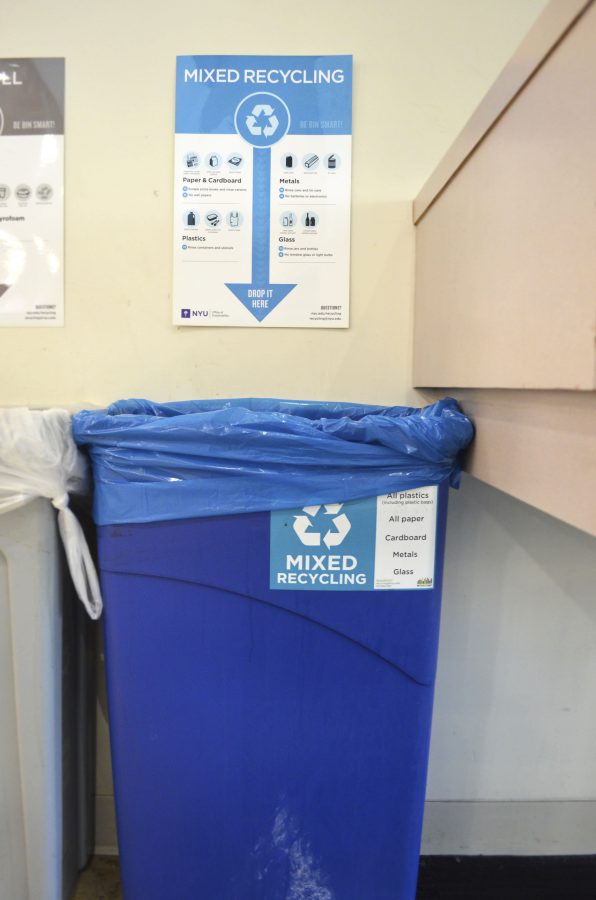Does NYU Really Recycle?
NYU claims to have a deep commitment to recycling. However, janitors are often spotted dumping recyclables and trash together.
Although it’s clear NYU actively works toward increasing sustainability at the university, my recent observations as a freshman student suggest that at least some of this eco-friendly pride is all just a front.
The NYU sustainability site has a page dedicated to affirming the university’s deep and historic commitment to recycling.
“NYU’s commitment to waste minimization goes back decades,” the statement on the website reads. “New York City passed the first of its many recycling laws in 1989, and in 1990, NYU established its Recycling Program, which has since become a model for institutionalized recycling in New York City.”
Despite this, I was not even through my first week of classes when I realized a trend — the NYU janitorial staff habitually dumps all the recyclables into a giant bin, along with the trash.
The first time I noticed this, I thought it might just be one janitor being lazy or unaware of NYU’s vigorous commitment to sustainability. However, I noticed this practice day after day — particularly in Bobst Library and the Kimmel Center for University Life, where I usually study. But, I wasn’t the only student who noticed this problem.
CAS senior Natalie Petrulla said that she conducted an experiment for class last year that observed how recycling is handled at Kimmel. She found that for some unknown reason, both recyclables and waste tend to be mixed together by the janitorial and maintenance staff.
“[We] had employees tell [me and my classmate] while sorting out our recycling materials that we should ‘put it all in the trash because it all goes to the same place,’” Petrulla said. “I spoke to one employee about why they do this, and they said that [Action Environmental Services] comes and sorts through it before they pick it up, but according to other [NYU employees], the company says that they just pick it up and [their] employees sort it.”
Petrulla said that there is clearly some confusion about this process, and she thinks it is unclear who exactly is sorting the recycled products — if anyone is doing it at all.
When questioned about this trend of mixing the university’s recycling with the trash, NYU’s Sustainability Department’s Overseer of Waste Management George Reis avoided directly commenting on recent student observations.
“Community education is a never-ending task for any recycling program, and that challenge is especially striking on a campus as large and complex as NYU’s,” Reis said. “We are always looking for ways to continually improve our process to increase recycling and reduce our waste stream in the first place, such as removing bottled water from student meal plans, food waste composting in the dining halls, and educating the community on sustainable purchasing practices.”
Reis said that thanks to a sophisticated off-campus optical sorting system employed by the university’s recycling and waste hauler, Action Environmental, NYU is available to offer mixed recycling for all paper, glass, plastics and metal. He said that in a typical month, NYU diverts about 140 tons of recycling material from landfills.
Reis’ words suggest that NYU’s recycling is sorted off-site. However, as stated above, other students have been told it is sorted here. Clearly, there is confusion regarding the sorting. It is therefore impossible to be sure if the recycling is being sorted at all.
Nikki Cabezal, a marketing strategist from Action Environmental Services, said that the company does the recycling but the university separates all of the material before it is picked up.
“All of the cardboard or paper is one container and the metal, plastics and glass are in another,” Cabezal said. “We then bring it to our Material Recovery Facility in the [Bronx] where it is dumped on a tipping flower. Then through a system of infrared camera machines it is separated by material — plastic goes one way, paper another, etc.”
Due to NYU’s size, it is virtually impossible to track down why some recycling is being thrown in with trash. I have tried to find the root of the problem, but as expected, neither the sustainability office nor university administration is willing to acknowledge that at least some of NYU’s recycling is not actually being recycled.
In such a large institution, it is possible that the problem simply exists amongst a few janitorial staff scattered throughout NYU, without being connected to a larger trend. However, these conflicting statements show that something fishy is going on in a school that prides itself on sustainability.
To solve this problem, everyone needs to hold the university accountable, and demand results that reflect the university’s outward sustainability efforts. We must all question whether the recycling is being mixed with the trash. Hopefully, we will find that NYU can truly live up to and exceed its claims of sustainability. If not, then we are only contributing to this unfortunate and disturbing hypocrisy.
Disclaimer: Opinions expressed are not necessarily those of WSN, and our publication of opinions is not an endorsement of them.
Email Andrew Heying at [email protected].












































































































































